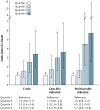Fibroblast growth factor 23 and mortality among patients undergoing hemodialysis
- PMID: 18687639
- PMCID: PMC2890264
- DOI: 10.1056/NEJMoa0706130
Fibroblast growth factor 23 and mortality among patients undergoing hemodialysis
Abstract
Background: Fibroblast growth factor 23 (FGF-23) is a hormone that increases the rate of urinary excretion of phosphate and inhibits renal production of 1,25-dihydroxyvitamin D, thus helping to mitigate hyperphosphatemia in patients with kidney disease. Hyperphosphatemia and low 1,25-dihydroxyvitamin D levels are associated with mortality among patients with chronic kidney disease, but the effect of the level of FGF-23 on mortality is unknown.
Methods: We examined mortality according to serum phosphate levels in a prospective cohort of 10,044 patients who were beginning hemodialysis treatment and then analyzed FGF-23 levels and mortality in a nested case-control sample of 200 subjects who died and 200 who survived during the first year of hemodialysis treatment. We hypothesized that increased FGF-23 levels at the initiation of hemodialysis would be associated with increased mortality.
Results: Serum phosphate levels in the highest quartile (>5.5 mg per deciliter [1.8 mmol per liter]) were associated with a 20% increase in the multivariable adjusted risk of death, as compared with normal levels (3.5 to 4.5 mg per deciliter [1.1 to 1.4 mmol per liter]) (hazard ratio, 1.2; 95% confidence interval [CI], 1.1 to 1.4). Median C-terminal FGF-23 (cFGF-23) levels were significantly higher in case subjects than in controls (2260 vs. 1406 reference units per milliliter, P<0.001). Multivariable adjusted analyses showed that increasing FGF-23 levels were associated with a monotonically increasing risk of death when examined either on a continuous scale (odds ratio per unit increase in log-transformed cFGF-23 values, 1.8; 95% CI, 1.4 to 2.4) or in quartiles, with quartile 1 as the reference category (odds ratio for quartile 2, 1.6 [95% CI, 0.8 to 3.3]; for quartile 3, 4.5 [95% CI, 2.2 to 9.4]; and for quartile 4, 5.7 [95% CI, 2.6 to 12.6]).
Conclusions: Increased FGF-23 levels appear to be independently associated with mortality among patients who are beginning hemodialysis treatment. Future studies might investigate whether FGF-23 is a potential biomarker that can be used to guide strategies for the management of phosphorus balance in patients with chronic kidney disease.
2008 Massachusetts Medical Society
Conflict of interest statement
Dr. Jüppner reports holding an active patent on the C-terminal FGF-23 assay manufactured by Immutopics. Dr. Wolf reports having a pending patent application on FGF-23 measurements as a diagnostic aid and receiving consulting and lecture fees from Abbott, Genzyme, and INEOS and grant support from Shire. Dr. Thadhani reports receiving consulting and lecture fees from Abbott and Genzyme and grant support from Abbott. No other potential conflict of interest relevant to this article was reported.
Figures

Comment in
-
FGF-23 and outcomes research--when physiology meets epidemiology.N Engl J Med. 2008 Aug 7;359(6):640-2. doi: 10.1056/NEJMe0804660. N Engl J Med. 2008. PMID: 18687647 No abstract available.
Similar articles
-
High levels of serum fibroblast growth factor (FGF)-23 are associated with increased mortality in long haemodialysis patients.Nephrol Dial Transplant. 2009 Sep;24(9):2792-6. doi: 10.1093/ndt/gfp191. Epub 2009 Apr 25. Nephrol Dial Transplant. 2009. PMID: 19395730
-
Fibroblast growth factor 23 and risks of mortality and end-stage renal disease in patients with chronic kidney disease.JAMA. 2011 Jun 15;305(23):2432-9. doi: 10.1001/jama.2011.826. JAMA. 2011. PMID: 21673295 Free PMC article.
-
Association of circulating fibroblast growth factor-23 with renal phosphate excretion among hemodialysis patients with residual renal function.Clin J Am Soc Nephrol. 2013 Jan;8(1):116-25. doi: 10.2215/CJN.00230112. Epub 2012 Oct 18. Clin J Am Soc Nephrol. 2013. PMID: 23085728 Free PMC article.
-
Fibroblast growth factor 23: associations with cardiovascular disease and mortality in chronic kidney disease.Int Urol Nephrol. 2014 Jan;46(1):9-17. doi: 10.1007/s11255-012-0370-2. Epub 2013 Jan 8. Int Urol Nephrol. 2014. PMID: 23296792 Review.
-
Clinical relevance of FGF-23 in chronic kidney disease.Kidney Int Suppl. 2009 Dec;(114):S34-42. doi: 10.1038/ki.2009.405. Kidney Int Suppl. 2009. PMID: 19946326 Review.
Cited by
-
Renal phosphate loss in long-term kidney transplantation.Clin J Am Soc Nephrol. 2012 Feb;7(2):323-31. doi: 10.2215/CJN.06380611. Epub 2011 Dec 1. Clin J Am Soc Nephrol. 2012. PMID: 22134626 Free PMC article.
-
FGF-23, vascular calcification, and cardiovascular diseases in chronic hemodialysis patients.Int Urol Nephrol. 2014 Jan;46(1):121-8. doi: 10.1007/s11255-013-0422-2. Epub 2013 Apr 3. Int Urol Nephrol. 2014. PMID: 23549862
-
Selective pharmacological inhibition of the sodium-dependent phosphate cotransporter NPT2a promotes phosphate excretion.J Clin Invest. 2020 Dec 1;130(12):6510-6522. doi: 10.1172/JCI135665. J Clin Invest. 2020. PMID: 32853180 Free PMC article.
-
Serum FGF23 and risk of cardiovascular events in relation to mineral metabolism and cardiovascular pathology.Clin J Am Soc Nephrol. 2013 May;8(5):781-6. doi: 10.2215/CJN.09570912. Epub 2013 Jan 18. Clin J Am Soc Nephrol. 2013. PMID: 23335040 Free PMC article.
-
Targeted deletion of Klotho in kidney distal tubule disrupts mineral metabolism.J Am Soc Nephrol. 2012 Oct;23(10):1641-51. doi: 10.1681/ASN.2012010048. Epub 2012 Aug 9. J Am Soc Nephrol. 2012. PMID: 22878961 Free PMC article.
References
-
- Jonsson KB, Zahradnik R, Larsson T, et al. Fibroblast growth factor 23 in oncogenic osteomalacia and X-linked hypophosphatemia. N Engl J Med. 2003;348:1656–63. - PubMed
-
- White KE, Jonsson KB, Carn G, et al. The autosomal dominant hypophosphatemic rickets (ADHR) gene is a secreted polypeptide overexpressed by tumors that cause phosphate wasting. J Clin Endocrinol Metab. 2001;86:497–500. - PubMed
-
- Autosomal dominant hypophosphataemic rickets is associated with mutations in FGF23. Nat Genet. 2000;26:345–8. - PubMed
-
- De Beur SM, Finnegan RB, Vassiliadis J, et al. Tumors associated with oncogenic osteomalacia express genes important in bone and mineral metabolism. J Bone Miner Res. 2002;17:1102–10. - PubMed
Publication types
MeSH terms
Substances
Grants and funding
LinkOut - more resources
Full Text Sources
Other Literature Sources
Medical
